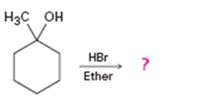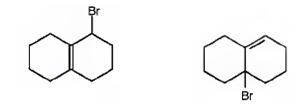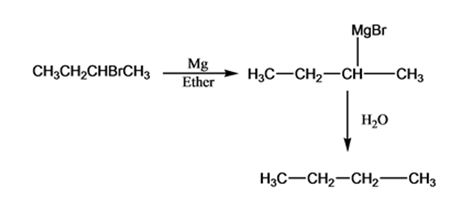
a)

Interpretation:
The product of the reaction shown is to be predicted.
Concept introduction:
Alcohols gets converted into the corresponding bromides on treatment with HBr in ether solution.
To predict:
The product of the reaction shown.
Answer to Problem 26AP
The product of the reaction shown is

Explanation of Solution
When 1-methylcyclohexanol is treated with HBr, the OH group in it is replaced by the bromine to yield 1-chloro-1-methylcyclohexane and water as products.

The product of the reaction shown is

b)

Interpretation:
The product of the reaction shown is to be predicted.
Concept introduction:
Alcohols when treated with SOCl2 yield the corresponding alkyl chlorides along with SO2 and HCl.
To predict:
The product of the reaction in which 1-butanol reacts with SOCl2 .
Answer to Problem 26AP
The product of the reaction in which 1-butanol reacts with SOCl2 is 1-chlorobutane.

Explanation of Solution
When 1-butanol reacts with SOCl2, the OH group in is replaced by chlorine to yield 1-chlorobutane. SO2 and HCl are obtained as other products.

The product of the reaction in which 1-butanol reacts with SOCl2 is 1-chlorobutane.
c)

Interpretation:
The product of the reaction shown is to be predicted.
Concept introduction:
Cycloalkenes on treatment with NBS in CCl4 in the presence of light undergo bromination at the allyl position.
To predict:
The product of the reaction shown.
Answer to Problem 26AP
The products of the reaction shown are

Explanation of Solution
NBS is normally used for allylic bromination. The reaction occurs through a radical mechanism. The radical produced by the homolytic cleavage of the C-H bond in the allyl position gets delocalized with the π electrons of the double bond to yield another radical with an odd electron at the junction of the rings. The attack of bromine radical hence leads to two different products as shown.
The products of the reaction shown are

d)

Interpretation:
The product of the reaction shown is to be predicted.
Concept introduction:
Alcohols give the corresponding bromides as products on treatment with PBr3 in ether solution.
To predict:
The product of the reaction in which cyclohexanol reacts with PBr3.
Answer to Problem 26AP
The product of the reaction in which cyclohexanol reacts with PBr3is

Explanation of Solution
When cyclohexanol is treated with PBr3, the OH group in it is replaced by the bromine to yield bromocyclohexane.

The product of the reaction in which cyclohexanol reacts with PBr3 is

e)

Interpretation:
The products of the reactions shown are to be predicted.
Concept introduction:
Alkyl bromides react with Mg in ether to give Grignard reagents. Grignard reagents when treated with water yield the corresponding
To predict:
The products of the reaction shown.
Answer to Problem 26AP
The products of the reaction shown are sec-butyl magnesium bromide (A) and n-butane (B).

Explanation of Solution
sec-butyl bromide when reacted with Mg in ether yields sec-butyl magnesium bromide, a Grignard reagent. The sec-butyl magnesium bromide reacts with water to yield n-butane.

The products of the reaction shown are sec-butyl magnesium bromide (A) and n-butane (B).

f)

Interpretation:
The products of the reaction shown are to be predicted.
Concept introduction:
To predict:
The product of the reaction shown.
Answer to Problem 26AP
The products of the reaction shown are N-butyllithium (A) and Lithium n-dibutyl copper (B).

Explanation of Solution
n-Butyl bromide reacts with Li to yield n-butyl lithium and lithium bromide. The n-butyl lithium produced when reacted with CuI yields Lithium n-dibutyl copper as the product.

The products of the reaction shown are N-butyllithium (A) and Lithium n-dibutyl

g)

Interpretation:
The product of the reaction shown is to be predicted.
Concept introduction:
When alkyl halides are treated with lithium dimethyl copper, the halogens are displaced by an alkyl group and a higher alkane is produced as the product.
To predict:
The product of the reaction in which n-butyl bromide reacts with lithium dimethylcopper.
Answer to Problem 26AP
The product of the reaction in which n-butyl bromide reacts with lithium dimethylcopper is n-pentane.

Explanation of Solution
When n-butyl bromide is treated with lithium dimethylcopper, the bromine is replaced by a methyl group to yield n-pentane as the product.

The product of the reaction in which n-butyl bromide reacts with lithium dimethylcopper is n-pentane.

Want to see more full solutions like this?
Chapter 10 Solutions
Bundle: Organic Chemistry, 9th, Loose-Leaf + OWLv2, 4 terms (24 months) Printed Access Card
- Name an interesting derivative of barbituric acid, describing its structure.arrow_forwardBriefly describe the synthesis mechanism of barbituric acid from the condensation of urea with a β-diketone.arrow_forwardGiven the hydrazones indicated, draw the structures of the enamines that can be formed. Indicate the most stable enamine (explain). C6H5 C6H5 H C6H5 Harrow_forward
- 4. Propose a Synthesis for the molecule below. You may use any starting materials containing 6 carbons or less (reagents that aren't incorporated into the final molecule such as PhзP do not count towards this total, and the starting material can have whatever non-carbon functional groups you want), and any of the reactions you have learned so far in organic chemistry I, II, and III. Your final answer should show each step separately, with intermediates and conditions clearly drawn.arrow_forwardIndicate the importance of the indole ring. Find a representative example and list 5 structures.arrow_forwardΌΗ 1) V2 CO 3 or Nalt In منهarrow_forward
- 6. The equilibrium constant for the reaction 2 HBr (g) → H2(g) + Br2(g) Can be expressed by the empirical formula 11790 K In K-6.375 + 0.6415 In(T K-¹) - T Use this formula to determine A,H as a function of temperature. Calculate A,-H at 25 °C and at 100 °C.arrow_forward3. Nitrosyl chloride, NOCI, decomposes according to 2 NOCI (g) → 2 NO(g) + Cl2(g) Assuming that we start with no moles of NOCl (g) and no NO(g) or Cl2(g), derive an expression for Kp in terms of the equilibrium value of the extent of reaction, Seq, and the pressure, P. Given that K₂ = 2.00 × 10-4, calculate Seq/ of 29/no when P = 0.080 bar. What is the new value по ƒª/ at equilibrium when P = 0.160 bar? Is this result in accord with Le Châtelier's Principle?arrow_forwardConsider the following chemical equilibrium: 2SO2(g) + O2(g) = 2SO3(g) • Write the equilibrium constant expression for this reaction. Now compare it to the equilibrium constant expression for the related reaction: • . 1 SO2(g) + O2(g) = SO3(g) 2 How do these two equilibrium expressions differ? What important principle about the dependence of equilibrium constants on the stoichiometry of a reaction can you learn from this comparison?arrow_forward
- Given Kp for 2 reactions. Find the Kp for the following reaction: BrCl(g)+ 1/2 I2(g) ->IBr(g) + 1/2 Cl2(g)arrow_forwardFor a certain gas-phase reaction at constant pressure, the equilibrium constant Kp is observed to double when the temperature increases from 300 K to 400 K. Calculate the enthalpy change of the reaction, Ah, using this information.arrow_forwardHydrogen bonding in water plays a key role in its physical properties. Assume that the energy required to break a hydrogen bond is approximately 8 kJ/mol. Consider a simplified two-state model where a "formed" hydrogen bond is in the ground state and a "broken" bond is in the excited state. Using this model: • Calculate the fraction of broken hydrogen bonds at T = 300 K, and also at T = 273 K and T = 373 K. • At what temperature would approximately 50% of the hydrogen bonds be broken? • What does your result imply about the accuracy or limitations of the two-state model in describing hydrogen bonding in water? Finally, applying your understanding: • Would you expect it to be easier or harder to vaporize water at higher temperatures? Why? If you were to hang wet laundry outside, would it dry more quickly on a warm summer day or on a cold winter day, assuming humidity is constant?arrow_forward

 Organic ChemistryChemistryISBN:9781305580350Author:William H. Brown, Brent L. Iverson, Eric Anslyn, Christopher S. FootePublisher:Cengage Learning
Organic ChemistryChemistryISBN:9781305580350Author:William H. Brown, Brent L. Iverson, Eric Anslyn, Christopher S. FootePublisher:Cengage Learning

